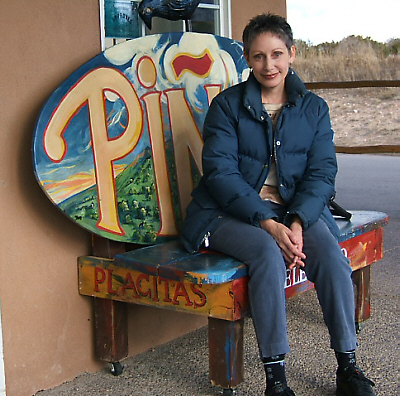|

Meg Fox
Why digital? For me it is a combination of the phenomenon of light and my curiosity about the connection between intangible thought and the physical world. So many of us wonder about our connection to the cosmos and the interrelationship of consciousness and the physical universe. On the digital canvas, light becomes my medium. I love the sheer beauty of emitted light and the brilliance and depth of color created by mixing light. These same electromagnetic waves, as they are reflected or emitted from matter in space, are the tool used to collect information about the universe. That this same ”tool” can be used to transform the energy of thought into a visual art form is, to me, like the magic of the stars. Light as medium has become the bridge between my imagination and the physical world, and as it travels through the vacuum of space, it reaches into the very heart of our existence—the universe.
And finally, I love the spiritual nature of light and the concept of a universal source of energy embraced by so many cultures for thousands of years. From ancient India and the energy of prana, and the ancient Chinese vital energy Qi, through Pythagorean universal light energy, the Kabbalah mystical teachings of astral light, halos found in Christianity and in Buddhism, and the Native American cultures where the interconnection of all creation is an ever flowing part of daily life.
Thoughts are my inspiration. I use digital collage to explore and express them, and most recently combine this with my love of language. I use the beauty of word in its symbolic letter form as a design element and am deeply mindful of the profound
psychological influence of the words we share as communication. Digital art has become my passionate journey toward what I believe to be the integral ensemble of substance, spirit and space.
Most of my professional career has been as a Los Angeles studio violinist working for over 30 years in the Motion Picture, Television, and Recording industries. When time permitted, I would pull out my favorite toys-my Prismacolor pencils. After an unexpected opportunity came along to create a line of greeting cards, I knew where my heart belonged, and over the last 10 years I began to scale back music performance to work more with visual art. After much experimenting, I fell in love with the computer for the many new ways I could use it to combine my traditional drawing, photography and collage.
My exposure to the integration of technology and the arts actually began in 1964 when my mother, a young pioneer of electronic music, purchased one of six prototypes of a waveform generator designed by Donald Buchla. Using an analogue sequencer that generated a series of voltages, these in turn controlled frequencies of oscillators and filters. Although it was called a "synthesizer" by the electronic and music industries, Buchla objected to the term because his "Electronic Music Box" was not built to imitate or “synthesize’ the sounds of traditional instruments, but was created to generate unique sounds and frequencies. Years later, as a working violinist, I could appreciate the importance of making this distinction when synthesizers specifically designed to recreate the sounds of orchestral instruments began replacing live musicians. To me, recording "synthesized" imitations of instruments with a small number of live players added to the mix can never replace the sound of the live symphony/studio orchestra. BUT, when the composer uses the unique sound/frequency capabilities of the synthesizer WITH a live symphony, amazing new "colors" of sound are created.
For me the same holds true for traditional fine art and digital fine art. Digital rendering is not a replacement for traditional media. Its beauty lies in the unique capabilities of the computer and the programs combined with the humanity of the artist. Then "digital" becomes a fascinating new tool with infinite possibilities for expression.
—Meg Fox
|

